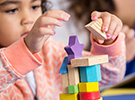Fill the Carton
In this lesson, children will practice counting and number recognition using numbers one thru twelve, an egg carton and small manipulatives such as pebbles.
Lesson for:
Toddlers/Preschoolers
(See Step 5: Adapt lesson for toddlers or preschoolers.)
Content Area:
Algebra
Numbers and Operations
Learning Goals:
This lesson will help toddlers and preschoolers meet the following educational standards:
- Understand numbers, ways of representing numbers, relationships among numbers and number systems
- Understand patterns, relations and functions
Learning Targets:
After this lesson, toddlers and preschoolers should be more proficient at:
- Counting with understanding and recognizing “how many” in sets of objects
- Sorting, classifying and ordering objects by size, number and other properties
- Connecting number words and numerals to the quantities that they represent, using various physical models and representations

Fill the Carton
Lesson plan for toddlers/preschoolers
Step 1: Gather materials.
- Egg cartons (Label the egg compartments in each carton 1 – 12)
- 78 small manipulatives (such as pebbles or small counters)
- Dice (2)
- The book, Ten Apples Up On Top by Dr. Seuss
Note: Small parts pose a choking hazard and are not appropriate for children age five or under. Be sure to choose lesson materials that meet safety requirements.
Step 2: Introduce activity.
- Read the book Ten Apples Up On Top by Dr. Seuss. Ask the children to count the apples on top of the animals’ heads.
- Explain that the children are going to play a game in pairs. The object of the “Fill the Carton” game is to roll the dice and then fill the carton with the corresponding number of pebbles until the carton is full.
Step 3: Engage children in lesson activities.
- Explain the game board (the egg carton) and show the children how to use the dice. Explain that there are numbers at the bottom of each egg compartment and that the children will be matching these numbers with the numbers on the dice.
- Model how to play the game. Let the children see you roll the dice. Say: “I have rolled an 8. What should I do? Put 8 pebbles in the compartment that says 8. Yes, that’s correct. Now it’s Sally’s turn.” The object of the game is to fill the carton.
- Explain that if a player rolls a number that is already filled, like an 8, than that player rolls again. After three tries, the other player gets a turn.
Additional Extensions
- Make up a counting worksheet to accompany the game. The sheet can include an adding component using numbers from 1-12. The sheet could also be a matching sheet, matching the numerical number with the written number with the pictorial representation of that number.
Step 4: Vocabulary.
- Count: To identify the amount of something by number (e.g., “How many blocks do you have? 1-2-3!” Point to each object while saying 1-2-3.)
- Corresponding: Similar in function and form (e.g.,”The dice roll is 8. Place the corresponding number of pebbles into the egg carton.”)
Step 5: Adapt lesson for toddlers or preschoolers.
Adapt Lesson for Toddlers
Toddlers may:
- Not yet count to 10 in sequential order or have mastered one-to-one correspondence with numbers 1-10
Child care providers may:
- Cut the egg carton in half and only use six of the egg compartments, one die and 21 pebbles
Adapt Lesson for Preschoolers
Preschoolers may:
- Easily work with numbers 1-12
Child care providers may:
- Make up a counting worksheet to accompany the game. The sheet can include an adding component using numbers from 1-12. The sheet could also be a matching sheet, matching the numerical number with the written number with the pictorial representation of that number.
Suggested Books
- Ten Apples Up On Top by Dr. Seuss (New York: Random House Books for Young Readers, 1998)
Music and Movement
Outdoor Connections
- Act out the book, Ten Apples Up On Top, using stackable pails that the children can wear on their heads. Assign some children to play the roles of the various animals and other to be the chorus. Read the story aloud and have the children stack the pails on their heads as the remaining children count out loud.
Comment on this lesson